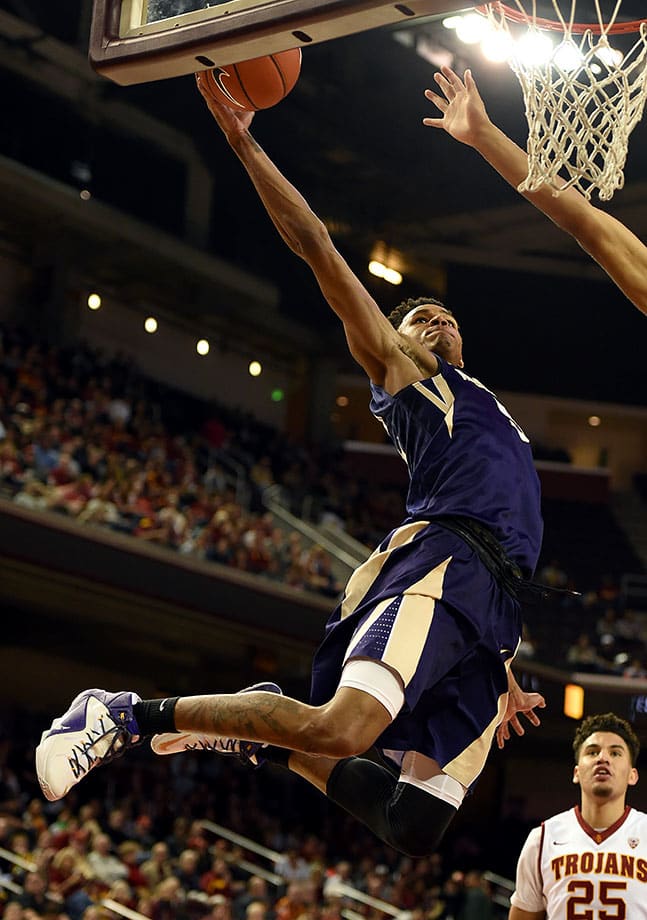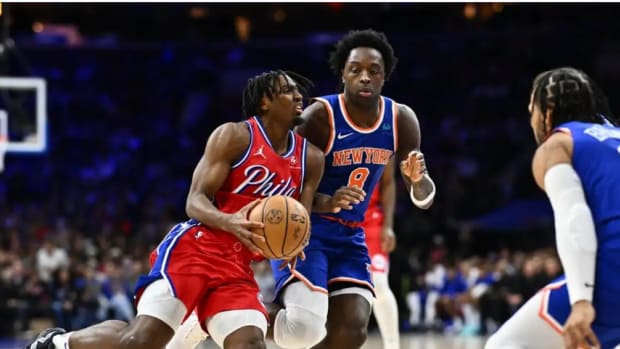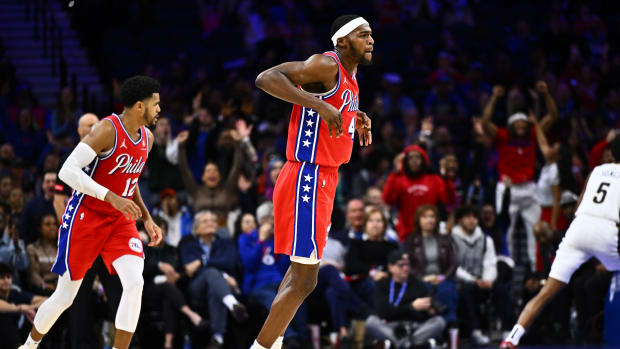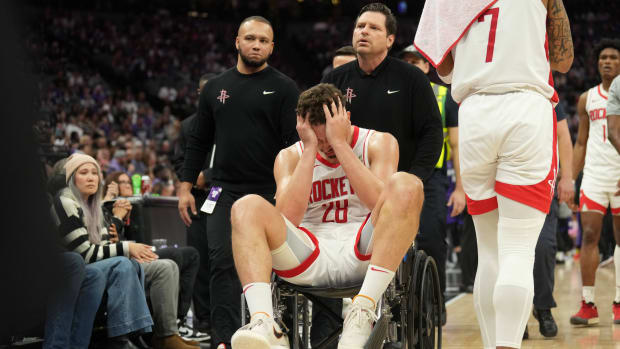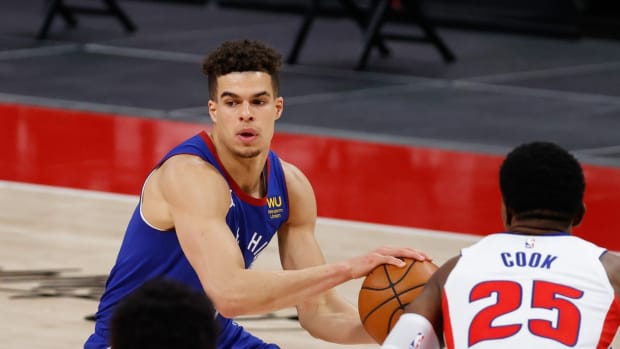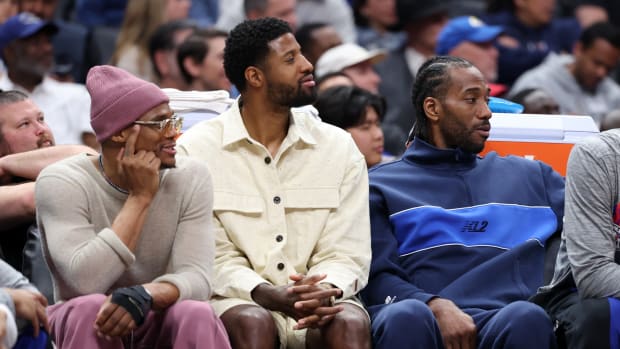No Cramming Needed: Jamal Murray ready for any challenge the NBA holds
Your teams. Your favorite writers. Wherever you want them. Personalize SI with our new App. Install on iOS or Android.
HARRISON, N.Y. — It’s a week before the NBA draft, and Jamal Murray knows this will be one of his final days on a basketball court before he’s officially a professional. Later tonight, he’ll leave for this sleepy suburb for New York City, and his calendar will overflow with promotional appearances and appointments with financial advisors and tailors and team representatives. But right now, he has just finished his final workout with fellow future lottery pick Brandon Ingram and before he has to film promos for Gatorade, he wants to try a few trick shots.
He starts with a traditional halfcourt attempt, which he sinks in short order. Then he walks to the three-point line, turns his back to the basket and launches the ball over his shoulder without looking. He hits that shot without much of a struggle. And since he’s already facing the wrong direction, he decides to step inside the three-point line and fire at the basket on the opposite side of the court. This requires a few more attempts, but he still gets the bucket.
Eventually he moves onto his more advanced material. He stands at halfcourt and heaves the ball in the air, trying to one-hop it into the rim. The Gatorade cameras are tracking him now, even between takes, so he wants to make sure he gets his shot. After about two dozen tries, he finally hits it. But he isn’t finished. “That’s not even my best shot,” he says.
• Mock Draft Roundtable: Projecting the first 30 picks of the 2016 NBA draft
For his best shot, he walks toward the three-point line and faces a carpeted wall. He does some mental geometry and then squares up and underhands the ball off the wall, sending it arcing toward the rim. He misses. He lines it up again and misses again. His PR rep implores him to break for lunch, but he’s determined now. He takes a total of 35 attempts before he’s finally convinced to walk away. “I’d make it if I had just a little more time,” he says.
Jamal Murray fully believes that he can make any shot on—or around—a basketball court. His confidence is rooted in the unorthodox training he endured and enjoyed nearly every day with his father, Roger Murray. And it’s that confidence that allows him, a week before the biggest night of his life, to obsess over a trick shot instead of over what city he’ll be living in next month.
“I’ve done my part,” Murray says. “I’ve trained and I’ve competed and I’ve proven myself. Everything I can control I can. I’m ready. All I can do now is wait.”
*****
Before Jamal could walk or talk or even babble, he held a basketball. Roger Murray had grown up in Jamaica obsessed with Bruce Lee movies and martial arts, but when he moved to Canada with his family at nine years old, he discovered basketball. He taped Michael Jordan’s games on TV and studied everything from his footwork to his shot motion and then took those lessons to the court. He didn’t play basketball for his high school team—he ran track instead—but by the time Jamal was born, he was spending every spare minute from work playing pickup or practicing.
He helped Jamal learn to crawl, walk and then dribble. He’d bring Jamal to all his pickup games, and by the time his boy could talk he was begging to play with the adults. Sometimes Roger would have to call a timeout in his games so that he could hoist Jamal in the air and let him take a few shots. Eventually, he’d pack Jamal’s yellow Fisher–Price hoop into the trunk and set it up on the sidelines so they could play at the same time.
• NBA Draft Big Board 4.0: Final rankings of the top 60 prospects
When Jamal was 3 or 4, Roger took a photo of him in the driveway beside that toy hoop and told his wife, Sylvia, that he would be in the NBA one day. He wanted Jamal to be prepared mentally and mechanically, so they began to train together every day.
Roger had learned about mindfulness meditation from Bruce Lee’s books, and he began teaching it to Jamal when he was about 4. If a fly landed on Jamal’s forehead, he’d tell his son to ignore it. If Jamal came home complaining about an argument with another kid, Roger would instruct him to contemplate the fight for one minute and then let it go for good. He’d sit with Jamal on the couch in the living room and create a game out of who could stay still the longest.
Eventually, he’d make concentrating more challenging. He’d make funny faces at Jamal or poke him to try to disrupt him. When Jamal was old enough, Roger introduced him to the idea of the chi, the Chinese concept for the life force that gives energy. “At first, it was all about mechanics,” Roger says. “You learn to control the muscles in your body, from your forehead to your feet. Then you learn to control what’s happening internally.”
He used the same method on the basketball court. Roger focused first on his son’s ballhandling and shooting, making sure that fundamentals became the solid foundation on his game. Then he began to prepare his son mentally. At the park near their house, he’d blindfold Jamal before he shot free throws. At the hoop in their backyard, he’d try to distract his son as he shot, making jokes or deriding him, telling him he should quit basketball because he wasn’t any good. Jamal learned to block it all out and swish shots regardless of sights or sounds.
•The case for Brandon Ingram as the No. 1 pick in the 2016 draft
By the time he was 6, Jamal was playing with 10-year-olds. By the time he was 10, he was challenging players at nearby Wilfrid Laurier University to shooting contests—and winning. Before middle school, Jamal would alternate each year between team basketball and individual training with his dad. Even after Roger injured his back badly and was unable to walk without a cane, he still trained Jamal daily. “I learned everything about basketball from my dad,” Jamal says. “He’s my mentor and my best friend.”
Some days Jamal would get tired of the training or the taunting, but he would look to his father’s example of preserving through pain and press on. “The great days,” Roger would tell him, “are the days when you’ve had enough.”
• Gallery: NBA Mock Draft: Projecting first 30 picks of 2016 draft
2016 NBA Mock Draft
1. Philadelphia 76ers: Ben Simmons, F, LSU (6'10", 240)
2. Los Angeles Lakers: Brandon Ingram, F, Duke (6'9", 195)
3. Boston Celtics: Jaylen Brown, G/F, Cal (6'7", 225)
4. Phoenix Suns: Marquese Chriss, F, Washington (6'9", 225)
5. Minnesota Timberwolves: Kris Dunn, G, Providence (6'4", 220)
6. New Orleans Pelicans: Jamal Murray, G, Kentucky (6'4", 205)
7. Denver Nuggets: Dragan Bender, F, Croatia (7'0", 220)
8. Sacramento Kings: Buddy Hield, G, Oklahoma (6'4", 215)
9. Toronto Raptors: Jakob Poeltl, C, Utah (7'1", 240)
10. Milwaukee Bucks: Deyonta Davis, F/C, Michigan State (6'10", 240)
11. Orlando Magic: Skal Labissiere, F/C, Kentucky (6'11", 220)
12. Atlanta Hawks: Domantas Sabonis, F, Gonzaga (6'10", 240)
13. Phoenix Suns: Timothe Luwawu, G/F, France (6'7", 205)
14. Chicago Bulls: Wade Baldwin IV, G, Vanderbilt (6'3", 195)
15. Denver Nuggets: Furkan Korkmaz, G, Turkey (6'5", 175)
16. Boston Celtics: Taurean Prince, F, Baylor (6'7", 220)
17. Memphis Grizzlies: Malachi Richardson, G, Syracuse (6'6", 195)
18. Detroit Pistons: Henry Ellenson, F/C, Marquette (6'10", 245)
19. Denver Nuggets: Malik Beasley, G, Florida State (6'5", 190)
20. Indiana Pacers: Denzel Valentine, G/F, Michigan State (6'6", 220)
21. Atlanta Hawks: Dejounte Murray, G, Washington (6'5", 170)
22. Charlotte Hornets: Juan Hernangomez, F, Spain (6'9", 225)
23. Boston Celtics: Ante Zizic, C, Croatia (6'11", 240)
24. Philadelphia 76ers: Demetrius Jackson, G, Notre Dame (6'1", 220)
25. Los Angeles Clippers: Cheick Diallo, F, Kansas (6'9", 218)
26. Philadelphia 76ers: Patrick McCaw, G, UNLV (6'7", 181)
27. Toronto Raptors: DeAndre Bembry, G, St. Joseph's (6'6", 220)
28. Phoenix Suns: Ivica Zubac, C, Croatia (7'1", 265)
29. San Antonio Spurs: Tyler Ulis, G, Kentucky (5'9", 149)
30. Golden State Warriors: Caris LeVert, G, Michigan (6'7", 205)
Jamal was more than ready by the time he reached high school. He became known for his dazzling and creative offense, for being able to sink shots from any angle and at any moment in games. Once, as a freshman, he injured his right shoulder but scored 26 points playing left-handed. In April 2015, as a junior, he earned MVP honors at the Nike Hoop Summit by scoring 30 points in the World Team’s win over Team USA. Later that summer, he scored all 22 of Team Canada’s points in the fourth quarter and overtime to secure a win over Team USA in the Pan American Games.
After those performances, he decided to graduate from high school a year early and enrolled at Kentucky. John Calipari could tell right away how well Roger had raised Jamal, but there was still plenty of room for improvement. After a February game against Georgia, Calipari told reporters that Jamal was addicted to bad shots “like crack cocaine.” He asked Jamal to inform him the next time he took a bad shot, but Jamal never copped to one.
“That’s him, though,” Calipari says. “What a great story if you want to know what he is and how he plays and how his mind works. … There’s not a shot that he doesn’t think he can make.”
•Special Delivery: Will Dragan Bender be the NBA's next Croatian star?
He finished his freshman season with the highest scoring average for a freshman ever at Kentucky (20 points per game) and nine three-pointers shy of Stephen Curry’s D-I freshman season record. When Jamal held a press conference to announce his decision to go pro, Roger sat right beside him.
“We always envisioned being here,” Roger told the room, “but we knew the work it would take to get here. He committed his own life to being here and did the work. It’s not an easy thing, but it’s very rewarding. Looking at him right now…”
Then, in a room full of reporters, Jamal hugged his dad for almost 20 seconds.
“He did his part,” Jamal said, “and now I’ve just gotta take it from here.”
*****
Before each game he plays, Jamal takes mental images of the court. He counts the steps from baseline to baseline and then closes his eyes and follows the same path again. He stands under the net and flips the ball of the backboard to test the bounce of both. He wants to control every factor he can. Once he’s satisfied, he retreats to the locker room to meditate.
On Thursday night in Brooklyn, he’ll wait for a fateful phone call in the green room. Cameras will monitor his every move, the crowd will cheer or jeer every pick and his cell phone will probably buzz every few seconds. But he won’t be distracted. He has already controlled everything he can. He won’t know where he is headed until he gets that phone call, but he is confident his father prepared him for whatever comes next.



















































